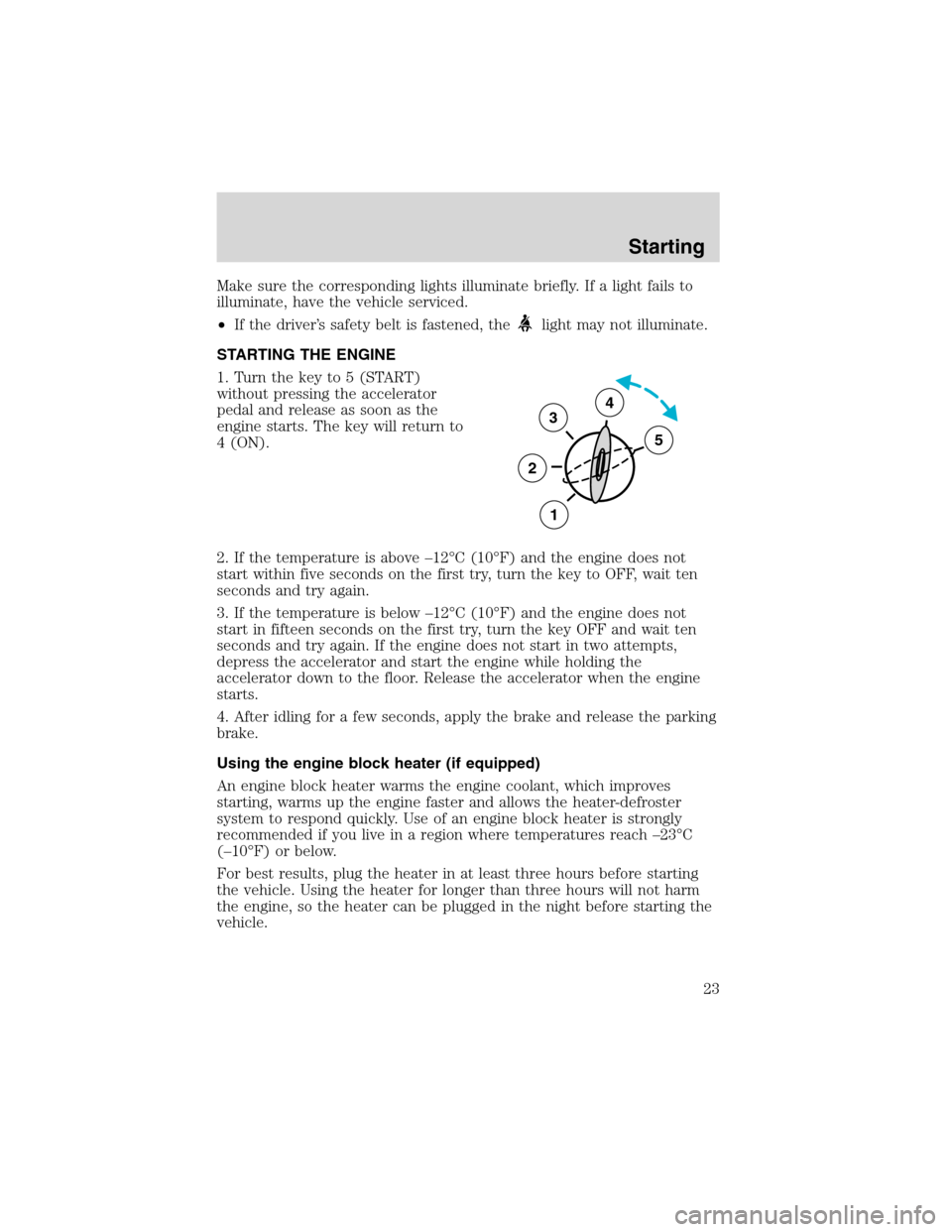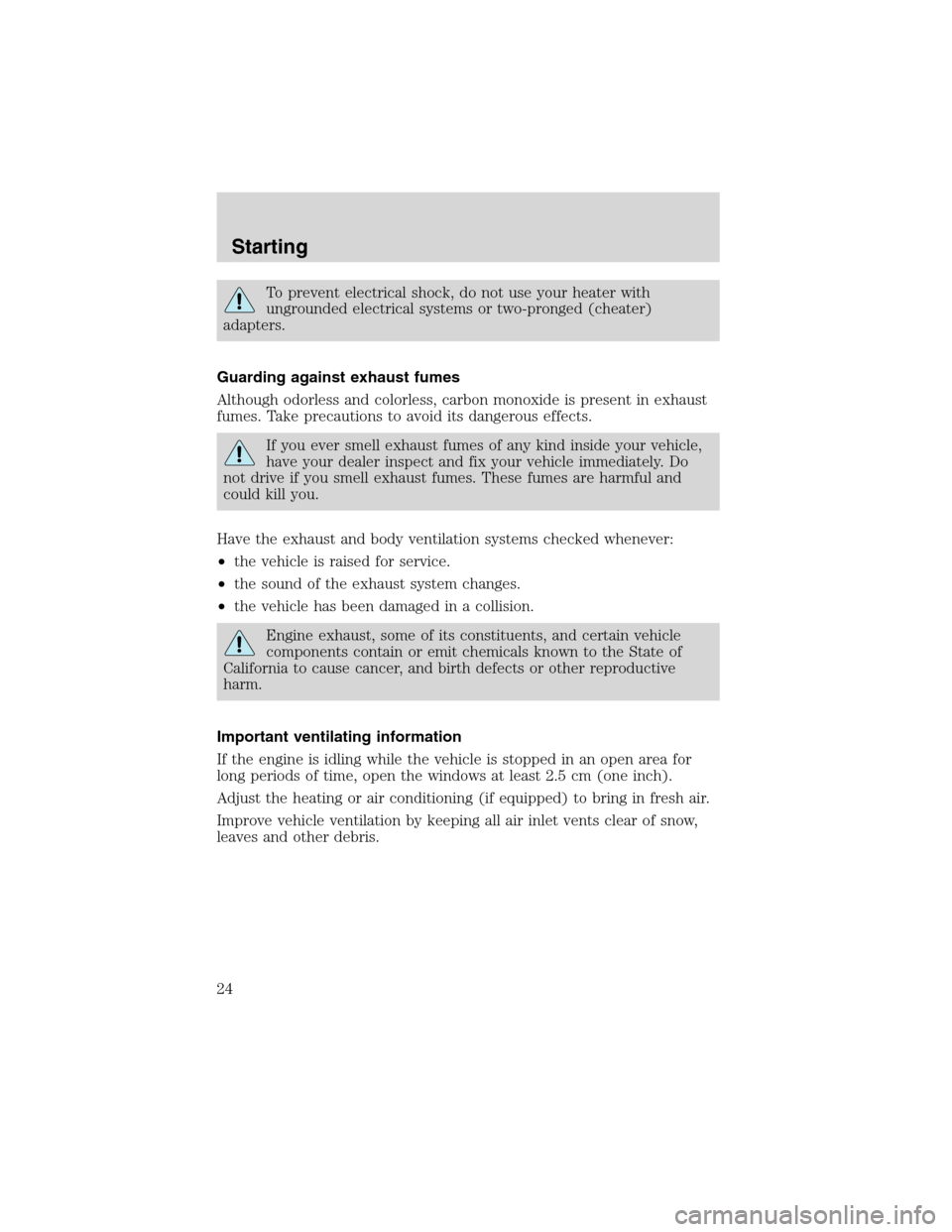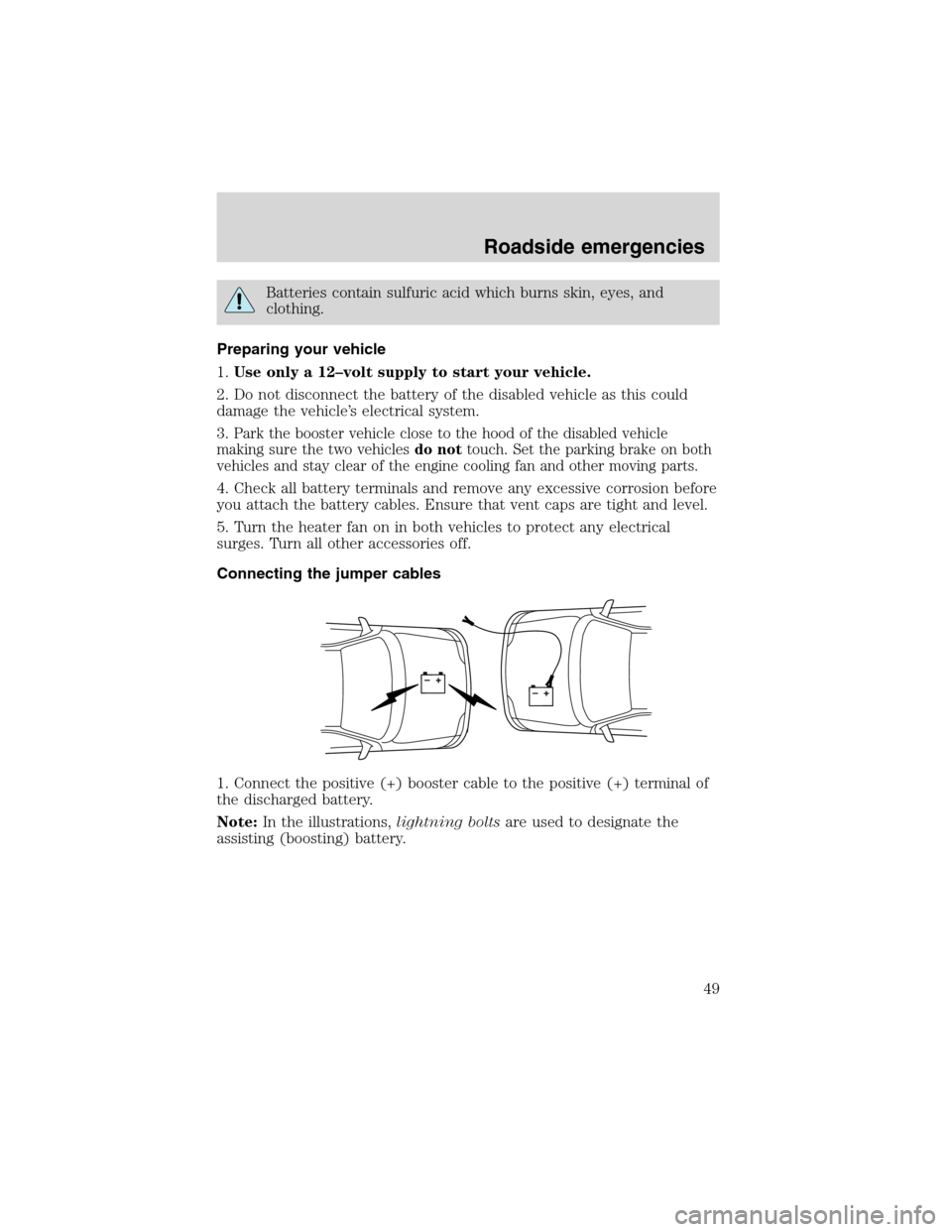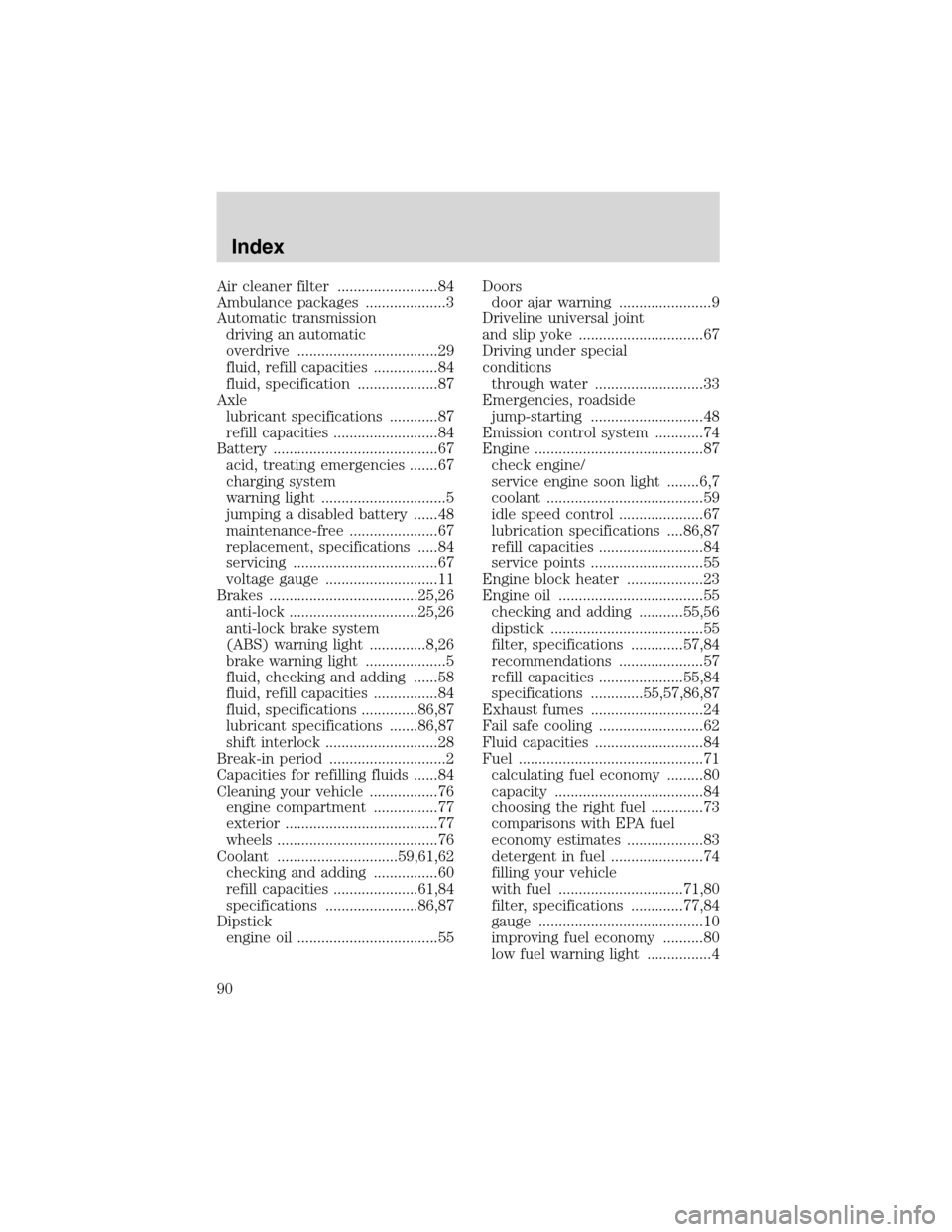heater FORD F SERIES MOTORHOME AND COMMERCIAL CHASSIS 1999 10.G Owners Manual
[x] Cancel search | Manufacturer: FORD, Model Year: 1999, Model line: F SERIES MOTORHOME AND COMMERCIAL CHASSIS, Model: FORD F SERIES MOTORHOME AND COMMERCIAL CHASSIS 1999 10.GPages: 96, PDF Size: 0.57 MB
Page 23 of 96

Make sure the corresponding lights illuminate briefly. If a light fails to
illuminate, have the vehicle serviced.
•If the driver’s safety belt is fastened, the
light may not illuminate.
STARTING THE ENGINE
1. Turn the key to 5 (START)
without pressing the accelerator
pedal and release as soon as the
engine starts. The key will return to
4 (ON).
2. If the temperature is above –12°C (10°F) and the engine does not
start within five seconds on the first try, turn the key to OFF, wait ten
seconds and try again.
3. If the temperature is below –12°C (10°F) and the engine does not
start in fifteen seconds on the first try, turn the key OFF and wait ten
seconds and try again. If the engine does not start in two attempts,
depress the accelerator and start the engine while holding the
accelerator down to the floor. Release the accelerator when the engine
starts.
4. After idling for a few seconds, apply the brake and release the parking
brake.
Using the engine block heater (if equipped)
An engine block heater warms the engine coolant, which improves
starting, warms up the engine faster and allows the heater-defroster
system to respond quickly. Use of an engine block heater is strongly
recommended if you live in a region where temperatures reach –23°C
(–10°F) or below.
For best results, plug the heater in at least three hours before starting
the vehicle. Using the heater for longer than three hours will not harm
the engine, so the heater can be plugged in the night before starting the
vehicle.
3
2
1
5
4
Starting
23
Page 24 of 96

To prevent electrical shock, do not use your heater with
ungrounded electrical systems or two-pronged (cheater)
adapters.
Guarding against exhaust fumes
Although odorless and colorless, carbon monoxide is present in exhaust
fumes. Take precautions to avoid its dangerous effects.
If you ever smell exhaust fumes of any kind inside your vehicle,
have your dealer inspect and fix your vehicle immediately. Do
not drive if you smell exhaust fumes. These fumes are harmful and
could kill you.
Have the exhaust and body ventilation systems checked whenever:
•the vehicle is raised for service.
•the sound of the exhaust system changes.
•the vehicle has been damaged in a collision.
Engine exhaust, some of its constituents, and certain vehicle
components contain or emit chemicals known to the State of
California to cause cancer, and birth defects or other reproductive
harm.
Important ventilating information
If the engine is idling while the vehicle is stopped in an open area for
long periods of time, open the windows at least 2.5 cm (one inch).
Adjust the heating or air conditioning (if equipped) to bring in fresh air.
Improve vehicle ventilation by keeping all air inlet vents clear of snow,
leaves and other debris.
Starting
24
Page 49 of 96

Batteries contain sulfuric acid which burns skin, eyes, and
clothing.
Preparing your vehicle
1.Use only a 12–volt supply to start your vehicle.
2. Do not disconnect the battery of the disabled vehicle as this could
damage the vehicle’s electrical system.
3.
Park the booster vehicle close to the hood of the disabled vehicle
making sure the two vehiclesdo nottouch. Set the parking brake on both
vehicles and stay clear of the engine cooling fan and other moving parts.
4. Check all battery terminals and remove any excessive corrosion before
you attach the battery cables. Ensure that vent caps are tight and level.
5. Turn the heater fan on in both vehicles to protect any electrical
surges. Turn all other accessories off.
Connecting the jumper cables
1. Connect the positive (+) booster cable to the positive (+) terminal of
the discharged battery.
Note:In the illustrations,lightning boltsare used to designate the
assisting (boosting) battery.
+–+–
Roadside emergencies
49
Page 90 of 96

Air cleaner filter .........................84
Ambulance packages ....................3
Automatic transmission
driving an automatic
overdrive ...................................29
fluid, refill capacities ................84
fluid, specification ....................87
Axle
lubricant specifications ............87
refill capacities ..........................84
Battery .........................................67
acid, treating emergencies .......67
charging system
warning light ...............................5
jumping a disabled battery ......48
maintenance-free ......................67
replacement, specifications .....84
servicing ....................................67
voltage gauge ............................11
Brakes .....................................25,26
anti-lock ................................25,26
anti-lock brake system
(ABS) warning light ..............8,26
brake warning light ....................5
fluid, checking and adding ......58
fluid, refill capacities ................84
fluid, specifications ..............86,87
lubricant specifications .......86,87
shift interlock ............................28
Break-in period .............................2
Capacities for refilling fluids ......84
Cleaning your vehicle .................76
engine compartment ................77
exterior ......................................77
wheels ........................................76
Coolant ..............................59,61,62
checking and adding ................60
refill capacities .....................61,84
specifications .......................86,87
Dipstick
engine oil ...................................55Doors
door ajar warning .......................9
Driveline universal joint
and slip yoke ...............................67
Driving under special
conditions
through water ...........................33
Emergencies, roadside
jump-starting ............................48
Emission control system ............74
Engine ..........................................87
check engine/
service engine soon light ........6,7
coolant .......................................59
idle speed control .....................67
lubrication specifications ....86,87
refill capacities ..........................84
service points ............................55
Engine block heater ...................23
Engine oil ....................................55
checking and adding ...........55,56
dipstick ......................................55
filter, specifications .............57,84
recommendations .....................57
refill capacities .....................55,84
specifications .............55,57,86,87
Exhaust fumes ............................24
Fail safe cooling ..........................62
Fluid capacities ...........................84
Fuel ..............................................71
calculating fuel economy .........80
capacity .....................................84
choosing the right fuel .............73
comparisons with EPA fuel
economy estimates ...................83
detergent in fuel .......................74
filling your vehicle
with fuel ...............................71,80
filter, specifications .............77,84
gauge .........................................10
improving fuel economy ..........80
low fuel warning light ................4
Index
90